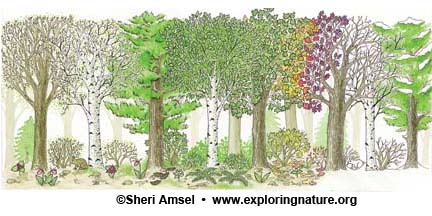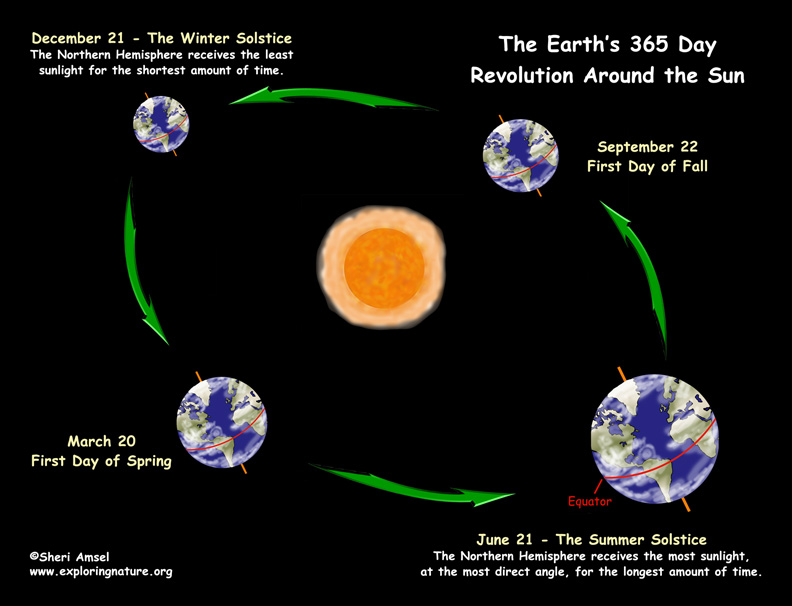


Many places on Earth have regular changes in the weather throughout the year. We call these the seasons. The seasons are affected by the amount of sunlight (solar radiation) an area gets throughout the year. Many things contribute to the amount of sunlight that reaches different areas on the Earth. These factors affect the changing seasons: The most important factor is the angle that the sunlight hits the Earth’s surface throughout the year. Direct sunlight is warmer than sunlight hitting the Earth at an angle. The other factor is length of the day – how long the sun shines on an area each day. Longer days get more sunshine.
The seasons are very different in the Northern Hemisphere than in the Southern Hemisphere. The equator, shown as an imaginary red line around the middle of the Earth, divides the Northern Hemisphere from the Southern Hemisphere. North America is in the Northern Hemisphere.
Every year, on June 21st North America receives the most sunlight, at the most direct angle, for the longest amount of time. This day is called the summer solstice and is considered the first day of summer. In the Southern Hemisphere, it is the exact opposite! They experience the winter solstice on that day – the shortest day of the year.
Each season is marked by it’s own weather and seasonal changes. Seasons in the Northern Hemisphere:
Fall (Autumn)
Beginning on September 22, fall is marked by gradual falling temperatures and the noon sun appearing lower in the sky. Days continue to grow shorter. Plant cycles end. Animals migrate south or prepare for winter sleep. Some animals grow warmer fur or feathers. Some change color to blend in with coming snow. For many animals this is mating season. The leaves of deciduous trees change color and drop off. In the Arctic, the sun no longer rises above the horizon. For the next six months the Arctic will be in darkness.
Winter
Beginning on December 21, the Northern Hemisphere is tilted the furthest away from the sun and we experience our coldest season - winter. This is the season of freezing cold temperatures, snowfall, wind, and ice. Many animals hibernate or sleep a lot to save energy. This helps them survive, because it takes energy to stay warm and in winter there are fewer plants to eat. After December 21st the sun is already beginning to climb higher in the sky each day and the days are slowly growing longer.
Spring
Beginning on March 20, spring is marked by longer days and the sun higher in the sky. The Northern Hemisphere is tilted toward the sun once more, with the equator getting direct sunlight at noon. As the days grow longer, temperatures rise and plants begin to bud and start their life cycles again. Migrating animals move north and those who spent the winter in the north begin to shed their winter coats. Birds build nests, find mates and start their breeding seasons. Mammals give birth to their young. Insects hatch and begin to feed.
Summer
Beginning on June 21, summer is the warmest season in the Northern hemisphere. Plants grow and provide food for herbivores. Herbivores gain weight and provide food for carnivores. Mammals and birds raise their young. Insects go through their life cycles and lay eggs. Summer is when all animals, including humans, take advantage of the warmer weather to eat fresh foods. Humans grow the fresh food we will eat all year. In early times, people only ate the fruits and vegetables they could store for winter. Now we bring fresh fruits and vegetables from the Southern Hemisphere and tropical climates, so we can have them year round.
The changing length of daylight throughout the year is the result of the Earth being tilted 23.5° on its axis. If the Earth stood straight up and down, we would have 12 hours of daylight and 12 hours of night all year round and everywhere on Earth. However, with the Earth's tilt, in the Northern Hemisphere, in the summer, the Arctic is tipped so far toward the sun that from March 20th to September 22nd the sun never stops shining there. Yet even though the Arctic gets almost constant sunlight for six months of the year, it still is not as hot as places nearer the equator. This is because the sun does not shine on the Arctic directly overhead, but at an angle.
This might make it seem like the hottest place in the Northern Hemisphere would be where the sun hits directly on June 21st, but it really takes several weeks to warm the Earth. So it is well into July before we feel the warmest temperatures. The temperatures also change throughout the day as the sun “rises” in the sky. As with the seasons, even though the most direct, intense sunlight is at noon, the day often reaches its warmest temperature sometime early in the afternoon.
The hottest place on record in North America is Death Valley, California, where it often reaches over 100° and once reached 134° F on July 10, 1913. The coldest place on record in North America is Prospect Creek, Alaska where it reached -80° F on January 23, 1971.
Again, the Earth is a sphere tilted on its axis (an imaginary line around which the Earth spins (rotates). As the Earth goes around the sun (revolves), the part that is closer to the sun gets more sunlight and experiences summer. The part further from the sun is in winter.
Because of the Earth's tilt, when the Northern Hemisphere is in summer, the Southern hemisphere is in winter. Temperate and Polar regions have four different seasons that rotate throughout every year – spring, summer, fall (autumn) and winter.
When you research information you must cite the reference. Citing for websites is different from citing from books, magazines and periodicals. The style of citing shown here is from the MLA Style Citations (Modern Language Association).
When citing a WEBSITE the general format is as follows.
Author Last Name, First Name(s). "Title: Subtitle of Part of Web Page, if appropriate." Title: Subtitle: Section of Page if appropriate. Sponsoring/Publishing Agency, If Given. Additional significant descriptive information. Date of Electronic Publication or other Date, such as Last Updated. Day Month Year of access < URL >.
Amsel, Sheri. "Changing Seasons - The Tilted Earth" Exploring Nature Educational Resource ©2005-2024. December 13, 2024
< http://www.exploringnature.org/db/view/Changing-Seasons-The-Tilted-Earth >


